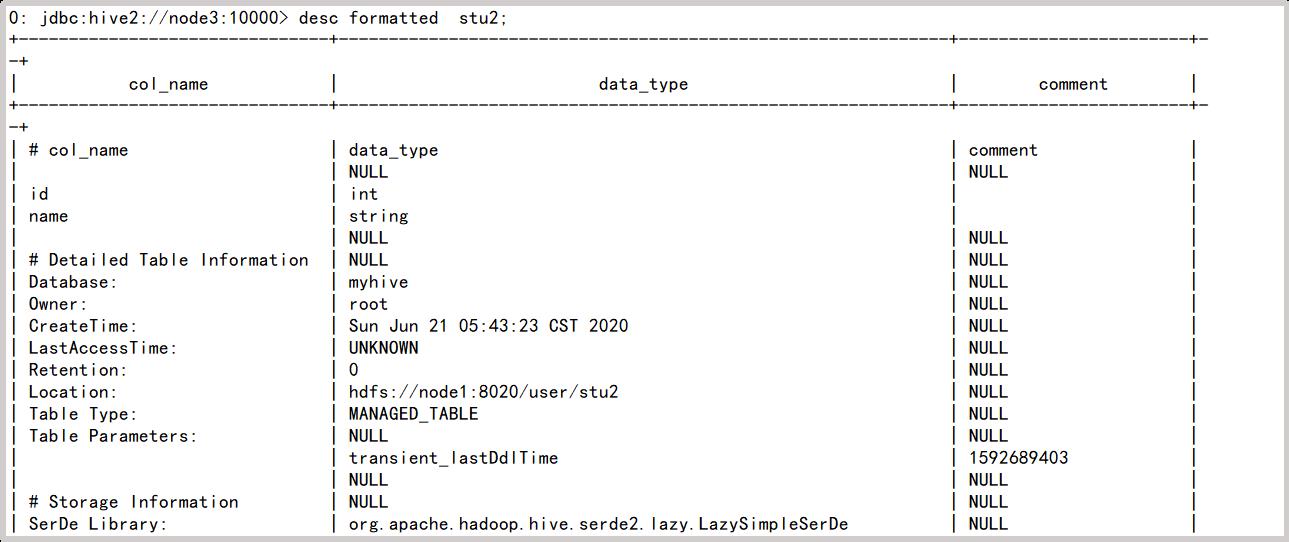2021年大数据Hive:手把手教你如何吃透Hive数据库和表操作(学会秒变数仓大佬)
Posted Lansonli
tags:
篇首语:本文由小常识网(cha138.com)小编为大家整理,主要介绍了2021年大数据Hive:手把手教你如何吃透Hive数据库和表操作(学会秒变数仓大佬)相关的知识,希望对你有一定的参考价值。
全网最详细的Hive文章系列,强烈建议收藏加关注!
后面更新文章都会列出历史文章目录,帮助大家回顾知识重点。
目录
系列历史文章
2021年大数据Hive(二):Hive的三种安装模式和MySQL搭配使用
2021年大数据Hive(一):Hive基本概念
前言
2021年全网最详细的大数据笔记,轻松带你从入门到精通,该栏目每天更新,汇总知识分享

Hive数据库和表操作
一、数据库操作
1、创建数据库
create database if not exists myhive;
use myhive;说明:hive的表存放位置模式是由hive-site.xml当中的一个属性指定的
<name>hive.metastore.warehouse.dir</name>
<value>/user/hive/warehouse</value>
2、创建数据库并指定hdfs存储位置
create database myhive2 location '/myhive2';
3、查看数据库详细信息
查看数据库基本信息
desc database myhive;
4、删除数据库
删除一个空数据库,如果数据库下面有数据表,那么就会报错
drop database myhive;强制删除数据库,包含数据库下面的表一起删除
drop database myhive2 cascade;
二、数据库表操作
1、创建数据库表语法
CREATE [EXTERNAL] TABLE [IF NOT EXISTS] table_name
[(col_name data_type [COMMENT col_comment], ...)]
[COMMENT table_comment]
[PARTITIONED BY (col_name data_type [COMMENT col_comment], ...)]
[CLUSTERED BY (col_name, col_name, ...)
[SORTED BY (col_name [ASC|DESC], ...)] INTO num_buckets BUCKETS]
[ROW FORMAT row_format]
[STORED AS file_format]
[LOCATION hdfs_path]说明:
1、CREATE TABLE 创建一个指定名字的表。如果相同名字的表已经存在,则抛出异常;用户可以用 IF NOT EXISTS 选项来忽略这个异常。
2、EXTERNAL 关键字可以让用户创建一个外部表,在建表的同时指定一个指向实际数据的路径(LOCATION),Hive 创建内部表时,会将数据移动到数据仓库指向的路径;若创建外部表,仅记录数据所在的路径,不对数据的位置做任何改变。在删除表的时候,内部表的元数据和数据会被一起删除,而外部表只删除元数据,不删除数据。
3、LIKE 允许用户复制现有的表结构,但是不复制数据。
4、ROW FORMAT DELIMITED 可用来指定行分隔符
5、STORED AS SEQUENCEFILE|TEXTFILE|RCFILE 来指定该表数据的存储格式,hive中,表的默认存储格式为TextFile。
6、CLUSTERED BY 对于每一个表(table)进行分桶(MapReuce中的分区),桶是更为细粒度的数据范围划分。Hive也是 针对某一列进行桶的组织。Hive采用对列值哈希,然后除以桶的个数求余的方式决定该条记录存放在哪个桶当中。
7、LOCATION 指定表在HDFS上的存储位置。
2、Hive建表时候的字段类型
| 分类 | 类型 | 描述 | 字面量示例 |
| 原始类型 | BOOLEAN | true/false | TRUE |
|
| TINYINT | 1字节的有符号整数 -128~127 | 1Y |
|
| SMALLINT | 2个字节的有符号整数,-32768~32767 | 1S |
|
| INT | 4个字节的带符号整数(-2147483648~2147483647) | 1 |
|
| BIGINT | 8字节带符号整数 | 1L |
|
| FLOAT | 4字节单精度浮点数1.0 |
|
|
| DOUBLE | 8字节双精度浮点数 | 1.0 |
|
| DEICIMAL | 任意精度的带符号小数 | 1.0 |
|
| STRING | 字符串,变长 | “a”,’b’ |
|
| VARCHAR | 变长字符串 | “a”,’b’ |
|
| CHAR | 固定长度字符串 | “a”,’b’ |
|
| BINARY | 字节数组 | 无法表示 |
|
| TIMESTAMP | 时间戳,毫秒值精度 | 122327493795 |
|
| DATE | 日期 | ‘2016-03-29’ |
|
| Time | 时分秒 | ‘12:35:46’ |
|
| DateTime | 年月日 时分秒 |
|
| 复杂类型 | ARRAY | 有序的的同类型的集合 | ["beijing","shanghai","tianjin","hangzhou"] |
| MAP | key-value,key必须为原始类型,value可以任意类型 | {"数学":80,"语文":89,"英语":95} | |
| STRUCT | 字段集合,类型可以不同 | struct(‘1’,1,1.0) |
3、内部表操作
未被external修饰的是内部表(managed table),内部表又称管理表,内部表数据存储的位置由hive.metastore.warehouse.dir参数决定(默认:/user/hive/warehouse),删除内部表会直接删除元数据(metadata)及存储数据,因此内部表不适合和其他工具共享数据。
1、hive建表初体验
create database myhive;
use myhive;
create table stu(id int,name string);
insert into stu values (1,"zhangsan");
select * from stu;
2、创建表并指定字段之间的分隔符
create table if not exists stu3(id int ,name string) row format delimited fields terminated by '\\t';
3、根据查询结果创建表
create table stu3 as select * from stu2;
4、根据已经存在的表结构创建表
create table stu4 like stu2;
5、查询表的类型
desc formatted stu2;
6、删除表
drop table stu2;查看数据库和HDFS,发现删除内部表之后,所有的内容全部删除
4、外部表操作
在创建表的时候可以指定external关键字创建外部表,外部表对应的文件存储在location指定的hdfs目录下,向该目录添加新文件的同时,该表也会读取到该文件(当然文件格式必须跟表定义的一致)。
外部表因为是指定其他的hdfs路径的数据加载到表当中来,所以hive表会认为自己不完全独占这份数据,所以删除hive外部表的时候,数据仍然存放在hdfs当中,不会删掉。
1、数据装载载命令Load
Load命令用于将外部数据加载到Hive表中
语法:
load data [local] inpath '/export/data/datas/student.txt' [overwrite] | into table student [partition (partcol1=val1,…)];参数:
- load data:表示加载数据
- local:表示从本地加载数据到hive表;否则从HDFS加载数据到hive表
- inpath:表示加载数据的路径
- overwrite:表示覆盖表中已有数据,否则表示追加
- into table:表示加载到哪张表
- student:表示具体的表
- partition:表示上传到指定分区
2、操作案例
分别创建老师与学生表外部表,并向表中加载数据
源数据如下:
student.txt
01 赵雷 1990-01-01 男
02 钱电 1990-12-21 男
03 孙风 1990-05-20 男
04 李云 1990-08-06 男
05 周梅 1991-12-01 女
06 吴兰 1992-03-01 女
07 郑竹 1989-07-01 女
08 王菊 1990-01-20 女
teacher.txt
01 张三
02 李四
03 王五
- 创建老师表:
create external table teacher (tid string,tname string) row format delimited fields terminated by '\\t';- 创建学生表:
create external table student (sid string,sname string,sbirth string , ssex string ) row format delimited fields terminated by '\\t';- 从本地文件系统向表中加载数据
load data local inpath '/export/data/hivedatas/student.txt' into table student;- 加载数据并覆盖已有数据
load data local inpath '/export/data/hivedatas/student.txt' overwrite into table student;- 从hdfs文件系统向表中加载数据
其实就是一个移动文件的操作
需要提前将数据上传到hdfs文件系统,
hadoop fs -mkdir -p /hivedatas
cd /export/data/hivedatas
hadoop fs -put teacher.csv /hivedatas/
load data inpath '/hivedatas/teacher.csv' into table teacher;注意,如果删掉teacher表,hdfs的数据仍然存在,并且重新创建表之后,表中就直接存在数据了,因为我们的student表使用的是外部表,drop table之后,表当中的数据依然保留在hdfs上面了
5、复杂类型操作
1、Array类型
Array是数组类型,Array中存放相同类型的数据
源数据:
说明:name与locations之间制表符分隔,locations中元素之间逗号分隔
zhangsan beijing,shanghai,tianjin,hangzhou
wangwu changchun,chengdu,wuhan,beijin
建表语句
create external table hive_array(name string, work_locations array<string>)
row format delimited fields terminated by '\\t'
collection items terminated by ',';导入数据(从本地导入,同样支持从HDFS导入)
load data local inpath '/export/data/hivedatas/work_locations.txt' overwrite into table hive_array;常用查询:
-- 查询所有数据
select * from hive_array;
-- 查询loction数组中第一个元素
select name, work_locations[0] location from hive_array;
-- 查询location数组中元素的个数
select name, size(work_locations) location from hive_array;
-- 查询location数组中包含tianjin的信息
select * from hive_array where array_contains(work_locations,'tianjin');
6、分区表
分区不是独立的表模型,要和内部表或者外部表结合:
内部分区表
外部分区表
1、基本操作
在大数据中,最常用的一种思想就是分治,分区表实际就是对应hdfs文件系统上的的独立的文件夹,该文件夹下是该分区所有数据文件。
分区可以理解为分类,通过分类把不同类型的数据放到不同的目录下。
分类的标准就是分区字段,可以一个,也可以多个。
分区表的意义在于优化查询。查询时尽量利用分区字段。如果不使用分区字段,就会全部扫描。
在查询是通过where子句查询来指定所需的分区。
在hive中,分区就是分文件夹
创建分区表语法
create table score(sid string,cid string, sscore int) partitioned by (month string) row format delimited fields terminated by '\\t';创建一个表带多个分区
create table score2 (sid string,cid string, sscore int) partitioned by (year string,month string,day string) row format delimited fields terminated by '\\t';加载数据到分区表中
load data local inpath '/export/data/hivedatas/score.csv' into table score partition (month='202006');加载数据到一个多分区的表中去
load data local inpath '/export/data/hivedatas/score.csv' into table score2 partition(year='2020',month='06',day='01');多分区联合查询使用union all来实现
select * from score where month = '202006' union all select * from score where month = '202007';查看分区
show partitions score;添加一个分区
alter table score add partition(month='202008');同时添加多个分区
alter table score add partition(month='202009') partition(month = '202010');注意:添加分区之后就可以在hdfs文件系统当中看到表下面多了一个文件夹
删除分区
alter table score drop partition(month = '202010');
7、分桶表
分桶就是将数据划分到不同的文件,其实就是MapReduce的分区
1、基本操作
将数据按照指定的字段进行分成多个桶中去,说白了就是将数据按照字段进行划分,可以将数据按照字段划分到多个文件当中去
开启hive的桶表功能(如果执行该命令报错,表示这个版本的Hive已经自动开启了分桶功能,则直接进行下一步)
set hive.enforce.bucketing=true;设置reduce的个数
set mapreduce.job.reduces=3; 创建分桶表
create table course (cid string,c_name string,tid string) clustered by(cid) into 3 buckets row format delimited fields terminated by '\\t';桶表的数据加载,由于桶表的数据加载通过hdfs dfs -put文件或者通过load data均不好使,只能通过insert overwrite
创建普通表,并通过insert overwrite的方式将普通表的数据通过查询的方式加载到桶表当中去
创建普通表:
create table course_common (cid string,c_name string,tid string) row format delimited fields terminated by '\\t';普通表中加载数据
load data local inpath '/export/data/hivedatas/course.csv' into table course_common;通过insert overwrite给桶表中加载数据
insert overwrite table course select * from course_common cluster by(cid);
8、修改表
1、表重命名
基本语法:
alter table old_table_name rename to new_table_name;-- 把表score3修改成score4
alter table score3 rename to score4;
2、增加/修改列信息
-- 1:查询表结构
desc score4;
-- 2:添加列
alter table score4 add columns (mycol string, mysco string);
-- 3:查询表结构
desc score4;
-- 4:更新列
alter table score4 change column mysco mysconew int;
-- 5:查询表结构
desc score4;
3、删除表
drop table score4;
4、清空表数据
只能清空管理表,也就是内部表
truncate table score4;
9、hive表中加载数据
1、直接向分区表中插入数据
通过insert into方式加载数据
create table score3 like score;
insert into table score3 partition(month ='202007') values ('001','002',100);通过查询方式加载数据
create table score4 like score;
insert overwrite table score4 partition(month = '202006') select sid,cid,sscore from score;
2、通过查询插入数据
通过load方式加载数据
create table score5 like score;
load data local inpath '/export/data/hivedatas/score.csv' overwrite into table score5 partition(month='202006');- 多插入模式
常用于实际生产环境当中,将一张表拆开成两部分或者多部分
给score表加载数据
load data local inpath '/export/data/hivedatas/score.csv' overwrite into table score partition(month='202006');创建第一部分表:
create table score_first( sid string,cid string) partitioned by (month string) row format delimited fields terminated by '\\t' ;创建第二部分表:
create table score_second(cid string,sscore int) partitioned by (month string) row format delimited fields terminated by '\\t';分别给第一部分与第二部分表加载数据
from score insert overwrite table score_first partition(month='202006') select sid,cid insert overwrite table score_second partition(month = '202006') select cid,sscore;- 查询语句中创建表并加载数据(as select)
将查询的结果保存到一张表当中去
create table score5 as select * from score;- 创建表时通过location指定加载数据路径
1、创建表,并指定在hdfs上的位置
create external table score6 (sid string,cid string,sscore int) row format delimited fields terminated by '\\t' location '/myscore6';2、上传数据到hdfs上
hadoop fs -mkdir -p /myscore6
hadoop fs -put score.csv/myscore6;3、查询数据
select * from score6;
10、hive表中的数据导出
将hive表中的数据导出到其他任意目录,例如linux本地磁盘,例如hdfs,例如mysql等等
1、insert导出
1)将查询的结果导出到本地
insert overwrite local directory '/export/data/exporthive' select * from score;2)将查询的结果格式化导出到本地
insert overwrite local directory '/export/data/exporthive' row format delimited fields terminated by '\\t' collection items terminated by '#' select * from student;3)将查询的结果导出到HDFS上(没有local)
insert overwrite directory '/exporthive' row format delimited fields terminated by '\\t' select * from score;
2、hive shell 命令导出
基本语法:(hive -f/-e 执行语句或者脚本 > file)
bin/hive -e "select * from myhive.score;" > /export/data/exporthive/score.txt
3、export导出到HDFS上
export table score to '/export/exporthive/score';
4、sqoop导出
由于篇幅有限,在项目实战的系列文章详细介绍
本博客大数据系列文章会一直每天更新,记得收藏加关注喔~
以上是关于2021年大数据Hive:手把手教你如何吃透Hive数据库和表操作(学会秒变数仓大佬)的主要内容,如果未能解决你的问题,请参考以下文章